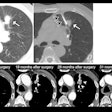Red Blood Cell Survival
This test is most commonly performed to evaluate suspected hemolytic processes. The radiolabel used is Cr-51 (T1/2 = 27.8 days, gamma = 324 KeV) which labels red blood cells of all ages (0-120 days). By plotting the activity of RBC's in a patient blood sample over time, an estimation of RBC life span can be made. The normal half-life of Cr-51 labeled RBC's is 25-35 days. The actual half-life of RBC's is 50-60 days, however, due to a 1% elution of Cr-51 from tagged RBC's per day, a half-life of 25-35 is obtained. Patients with beta-chain abnormalities may have more rapid elution rates. Care must be taken during the labeling process to ensure RBC's are not damaged, as this will shorten their life.
Technique
[Nuclear Medicine Technology and Techniques. 1981]
- Withdraw 10cc of venous blood into a syringe containing 2cc ACD as an anticoagulant.
- Transfer the blood to a sterile vial and add 100uCi Cr-51 (1.5 uCi/Kg of patients weight). Allow this to incubate at room temperature for 10-15 minutes.
- Add 50mg of ascorbic acid to the vial of blood in order to reduce the Cr-51 from its hexavalent to trivalent state and stop the tagging process.
- Inject the tagged blood into the patient and wait 24 hours before drawing any samples. This allows removal from the circulation of any RBC's damaged during the labeling process and allows clearance of any injected plasma activity.
- Starting at 24 hours, a 6cc sample of blood is drawn from the patient and this is repeated every other day for the next three weeks.
- 4cc of whole blood is pipetted into counting vials and a hematocrit determination is performed on each sample.
Calculations
The net counts per minute of each sample is plotted on semi-log paper (Y- axis) with time plotted along the X-axis. The points are connected and extrapolated back to intercept the Y-axis at time T0. From this, the time at which 50% of RBC activity remains is found, and this is the RBC half-life.
Alternatively, the first sample at 24 hours can be considered a standard, and the percent RBC survival each day calculated in relation to this standard:
Net counts for that day x 100 % RBC survival on a given day = --------------------------------------- Net counts of the standard for that day
[Sisson, J. Red Blood Cell Survival Including Red Blood Cell Sequestration. CRC Manual of Nuclear Medicine Procedures. ]
Changes in hematocrit values of greater than 2% during the study indicate that a steady state does not exist. Possibilities include; blood loss or blood transfusions performed during the test which will alter RBC survival calculations.
Splenic Sequestration Study
Following injection of Cr-51 labeled RBC's as above, a counting probe is used to measure activity over the liver ( patient supine, mid-clavicular line), spleen (Patient prone, 9-10th ribs) and precordium ( 3rd intercostal space at left sternal border). These sites are marked with permanent ink so that measurements are taken at the exact same location each time. Counting is started 24 hours after injection of labeled RBC's and can be performed every other day with blood draws if RBC survival is being calculated. The normal spleen:liver and spleen:precordium ratio is 1:1. An elevated spleen:liver >2.5:1 is considered clearly abnormal and patients are thought to benefit from splenectomy. It should be noted, however, that splenomegaly itself may produce an elevated ratio, and in this case, a rising ratio over time is indicative of significant splenic sequestration.















